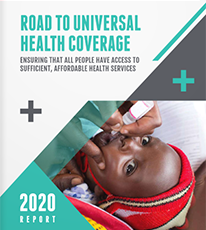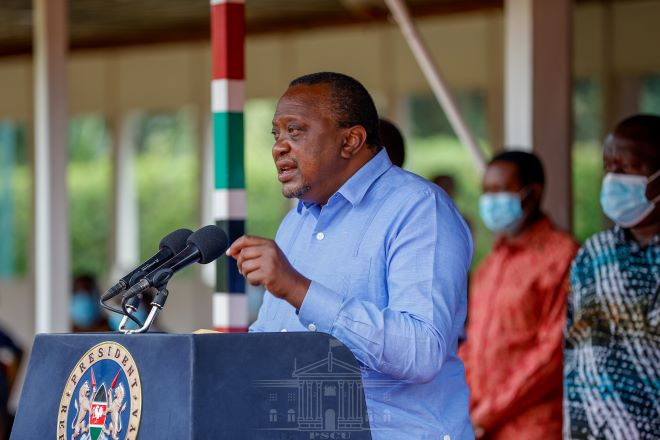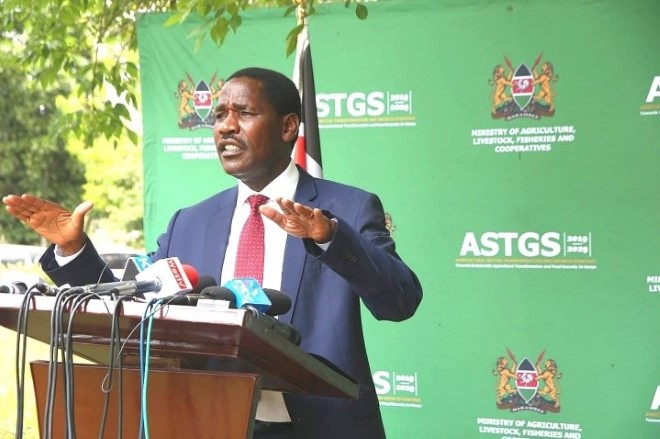
2022 Yearbook


Road to universal health coverage

First Lady calls for renewed vigour to shield infants from HIV and syphilis
First Lady Margaret Kenyatta on Tuesday, March 23 called for a renewed commitment to the elimination of mother-to-child transmission (eMTCT) of HIV and Syphilis in the country.
She called for concerted efforts to accelerate the progress made towards achieving eMTCT through the promotion of stronger partnerships.
“I am convinced, that our successes rely on harmonised efforts from both the public and private sectors.
“I believe that our targets are achievable because of the solid partnerships we have built with you,” she said.
The First Lady spoke when she virtually addressed a partnership meeting on accelerating the progress towards achieving validation for the elimination of mother-to-child transmission of HIV and syphilis by 2021.
Records show that Kenya has made great progress towards the elimination of mother-to-child transmission of HIV and curbing maternal mortality with new HIV infections reducing by 47 per cent from 12,826 in 2013 to 6,806 in 2020.
This success is partly due to the Kenya Framework for the Elimination of Mother-to-Child Transmission of HIV and Syphilis 2016-2021 launched by the First Lady in 2017 during a Beyond Zero Summit.
She commended the innovative implementation of the Kenya eMTCT Framework adopted by counties through the county business plan model.
“So far, we have successfully launched 11 county business plans. It is my hope that we, as partners, will commit to resourcing and supporting the remaining county governments on their respective journeys,” she said.
The county business plans provide for the sustainable and timely implementation of activities for counties to meet their unique eMTCT circumstances.

Full speech by President Uhuru Kenyatta on Covid-19 Pandemic
President Uhuru Kenyatta on Friday, March 26 issued fresh directives including a partial lockdown of five counties of Nairobi, Kajiado, Machakos, Kiambu and Nakuru to address a surge in cases of Covid-19.
Delivering the 15th Presidential Address on the Coronavirus Pandemic from State House Nairobi, President Uhuru decried a positivity rate he said is at its highest since the pandemic struck, a devastating death rate and unparalleled stress the pandemic is placing on the health system.
“What is even more worrying is the rising death rate from COVID. Between January and February 2021, three (3) people died every day from COVID; in March 2021, the number has gone up to seven (7) every day, the highest since this pandemic hit us,” the President said.
“Equally worrisome is how this COVID crisis has TESTED our health system. Over the last one month, we have experienced a steep and sustained rise in the number of admissions for COVID-19 across the country,” he added.
Read the Full Statement here

Govt reviews minimum price for cane deliveries upwards
The government has directed millers to adhere to the minimum price of cane adjusted from the current Sh3,700 per tonne to Sh4,040 per tonne effective April 1, 2021.
The upward review of the minimum recommended cane price to be paid to the farmer was arrived at by the Sugarcane Pricing Committee owing to the prevailing high sugar ex-factory prices over the past three months in Kenya.
In a statement delivered from Kilimo House, Nairobi on Tuesday, the Agriculture Cabinet secretary asked any farmer being paid less to report to the Agriculture and Food Authority (AFA).
“Any cases of non-compliance will attract a fine of not less than Sh500,000 or one-year imprisonment as per Section 37 of the Crops Act, 2013,” he said.
At the same time, a new model of paying cane deliveries based on quality is set to replace the century-old system that paid in terms of tonnage.
In the statement that dwelt on a wide range of issues in the sugar industry, Munya also said that a roadmap for implementation of the Quality-Based Cane Payment system is at an advanced stage.
“We hope to roll it out in July 2021,” he said, adding that the system will, among other things, serve as an incentive for high quality management in production process.
Read the Statement in Full

Kenya Yearbook 2013
“As Kenya celebrates its Jubilee year of freedom and independence, Africa too marks slightly over 50 years since the fall of colonialism. The breakaway from colonialism has not been easy. Indeed it has been fraught with great challenges and setbacks. Without fail, however, the trajectory of our recent history, in Kenya as in Africa, has been one of great hope, renewed progress and palpable determination.”
President Uhuru Kenyatta’s inaugural address to the nation on
April 9, 2013, after he was sworn in as Kenya’s fourth President

This is how you can earn more from dairy farming
Selective breeding and proper feeding is the key to high milk production, a prominent Nakuru County commercial dairy farmer says.
Mr Edward Njuguna, of Jasho Dairy Herd farm, at Ol’Rongai in Rongai constituency, adds: “The kind of semen you use in artificial insemination and what you feed your cows, determines the volume and quality of milk you expect from your herd.”
According to him, about 60 per cent of the productivity is determined by selective breeding, while the rest is dependent on the feeding programme.
Each of Mr Njuguna’s Holstein cows produces between 30 and 50 litres of milk a day. The farmer spends between Sh4,000 and Sh7,000 on high-quality gender-selective semen imported from Europe or America, where pedigree Holstein Friesians are bred.
“I carefully select semen that upgrades my breed. It must have attributes that increase milk production by 3.0 (litres), boosts herd longevity and health,” he says.
He first ventured into commercial dairy farming 16 years ago, with only four cows on his 10-hectare farm at Ol’Rongai. With a capital of Sh100,000, the farmer was able to buy each of the four Holstein Friesians at Sh15,000 in 1997, build stalls, plant fodder and Columbus grass on nine hectares and maintain a six-month feeding and health check programme.
His herd has grown to over 35 cows, and he is now a much sought-after farmer, not only by the public and private agricultural organisations but also by farmers in other countries.
“I receive farmers from all over Kenya, Zambia, South Africa, the US and the United Kingdom. They come for success tips. I only charge them Sh200,” says Mr Njuguna.
The use of AI, Mr Njuguna notes, keeps the herd healthy and prevents inbreeding, which reduces milk production.
“The worst mistake I can ever make is to let my cows run into a bull. This way, you are attracting diseases, encouraging inbreeding and are unaware of the type of bull. That is the beginning of a journey to five to 10 litres of milk per cow per day,” says the farmer.
His choice of semen varies, depending on the ability to boost milk production by not more than 3.0 points at one calving or lactation to prevent the cow from mastitis.
However, it must be able to maintain a high butter content of about 4.3 per cent and 40 per cent protein. This makes his milk a variable ingredient to all types of milk products, including whole, skimmed, non-skimmed, cheese, butter and yoghurt.
He also maintains a 420 calving interval (days) to allow the heifers a comfortable resting period for maximum upgrading and high milk production. Mr Njuguna keeps his herd on a daily seven-kilo gramme Total Mixed Ration, which is composed of silage, hay, dairy meal concentrate and green chop. Every cow gets 70 litres of water daily.
“I determine the quantity and quality of the nutrients my cows should take to produce the volumes of milk I want.”
He ensures that at least 40 per cent of the content is protein, 17 per cent starch, while the rest is made up of minerals like sulphur and phosphate, which are equally crucial for milk production. He maintains a high dry matter of 40 per cent for the green chop, which supplements the little starch provided in the hay and silage.
“You do not feed cows to their satisfaction in total disregard of the nutrients contained in the feed. You feed them to produce milk and stay healthy,” he says.
Columbus grass and the fodder he planted save him 90 per cent of the total spent on feeds, as he only buys the dairy meal concentrate. To give the cows more time for milk production, he feeds them twice daily at three-hour intervals.
“Cows should spend more than 14 hours resting and chewing cud. This is the time they produce milk. I spend about five hours feeding them while the rest of the time they spend producing milk,” Mr Njuguna says.
Unlike when he used to be paid Sh4 per litre in 1997 upon delivery, he now gets Sh34 for every litre of milk. Mr Njuguna delivers 400 litres daily to a milk processor from an average of 15 cows.
To ensure proper care and maintenance of his cows, Mr Njuguna says he allocates each cow an amount of money daily to cover for feeding, medical and other emergency costs that may arise. He also sprays them weekly to fend off ticks and ensures they get a health check every two months. Njuguna says that to get into the business, one needs a starting capital of more than Sh500,000. Holsteins and Friesians cost between Sh150,000 and Sh200,000, and starting with at least 10 cows is cost-efficient.
One needs a six-month feeding programme at Sh9,000 per cow. Other costs include the zero-grazing stall at Sh10,000 and AI, health, labour, and water costs, at Sh200,000.
“A proper six-month breeding and feeding programme can cost over Sh500,000, depending on the breeds, number, availability of feed, water and labour,” says Mr Njuguna, who began reaping profits in the first month.
The key to success, according to the farmer, is maintaining a comprehensive fixed management strategy. A herd must be reared in dry, clean, comfortable and draught-free stalls so provide them with a good environment and time to produce milk. Feeding troughs must also be easily accessible.
For dozens more of informative articles on farming, get a copy of ‘Towards Food Security’ from the ‘Bookstore’ tab at the top

Building Sustainable Homes: Innovations for Affordable Housing
The Kenya Yearbook Editorial Board (KYEB) will tomorrow (Thursday, 24th February, 2022) launch the book Building Sustainable Homes: Innovations for Affordable Housing, produced in partnership with the Kenya Building Research Centre (KBRC) of the State Department for Public Works.
The book Building Sustainable Homes: Innovations for Affordable Housing provides information on the use of sustainable building materials for low-cost housing as determined by local availability of raw materials, construction methods, the buying power of individuals, households, and residents’ groups; and the willingness of entrepreneurs to partner with the Government to build homes.
In his preface to the book, the Principal Secretary in the State Department for Public Works, Mr. Solomon Kitungu notes that it “forms a rare resource material aimed at providing information on availability, viability, affordability and sustainability of building materials, processes and technologies as well as enhanced public adoption.” Says the PS: “It is earmarked to facilitate effective information sharing through regional and national workshops, seminars and conferences; exhibitions and trade fairs and shows; libraries including all online technologies and social media.”
KYEB has adopted a Digital First Strategy for all its sector-based publications, including its flagship the Kenya Yearbook, that will see them first released and disseminated online, before printing, allowing for public feedback to be incorporated in the printed editions.
Building Sustainable Homes: Innovations for Affordable Housing captures the spirit of MTP III whose theme is “Transforming Lives: Advancing Socioeconomic Development through the Big 4 Agenda”. MTP III is in its final cycle, to be replaced by MTP IV after 30th June 2022. MTP III laid a firm foundation for transformational sector policies, programme
